Although we all love League of Legends, there’s something different about playing board games. It’s face-to-face interaction, and you get to rage at your friends IRL.
There are countless board games to choose from, with options getting more creative every day. Even more so thanks to 3D printing, which has removed many limitations on accessories and allowed independent creatives to come up with new game concepts.
In this list, we’ve selected the best board game models for you to 3D print. We’re not looking at gaming accessories (though we’ve got lists of dice and towers if that’s what you need)! Instead, these are full board games and expansion sets.
If you see your perfect game but don’t have the patience to print it yourself, try a service like Craftcloud. With suppliers around the world ready to print 32 pieces for your new checkers set, you’ll be winning battles before you know it!
Originals
These games are original creations from the maker community. Some are more board-based than others, but all will be great fun and unlike anything you’ve played before!
Spool Race
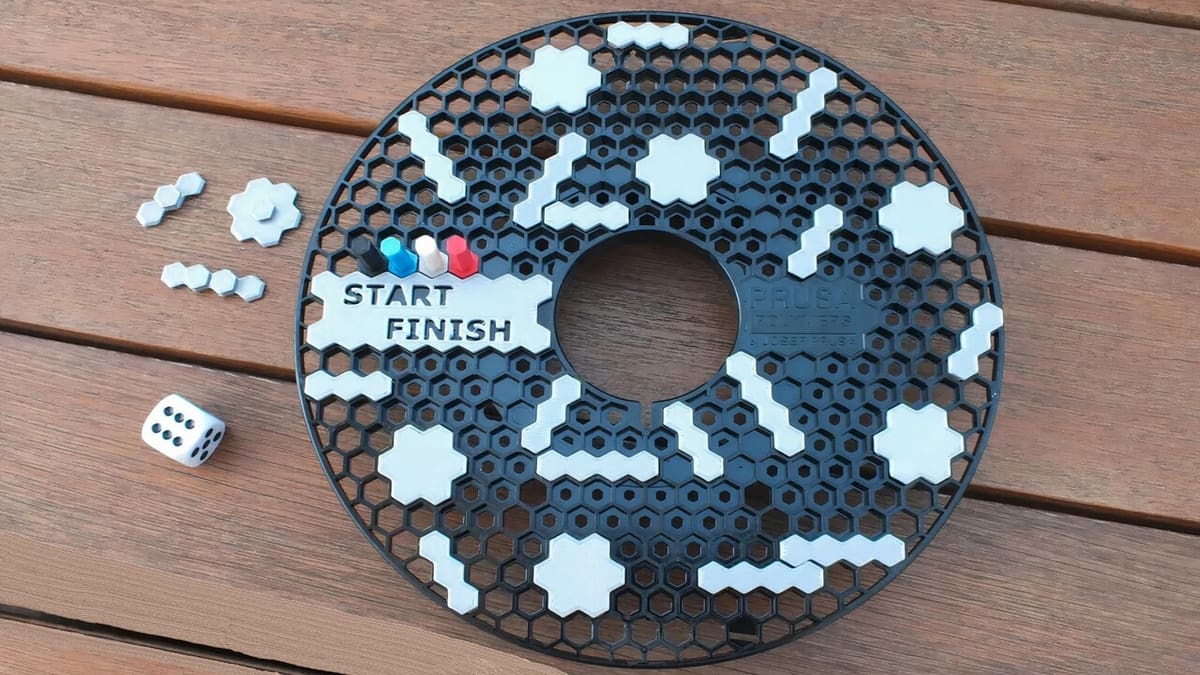
Spool Race is a game that involves repurposing Prusament spools. In this fast-paced game, players race to the finish line. Simply install the start/finish line on the left side of the spool and then place your barriers on the spool to create the path you want. For each roll, you can progress as many hexagonal holes as the number you roll on the dice.
The designer recommends printing the pieces with 100% infill. Since you can change the placement of the barriers before each round, no two Spool Race games are ever the same. You’ll have a unique and thrilling experience each time you play!
- Who designed it? Alpes86
- How printable/popular is it? This game has around 270 downloads and 10 shared makes.
- Where to find it? Printables
Don't Break the Ice
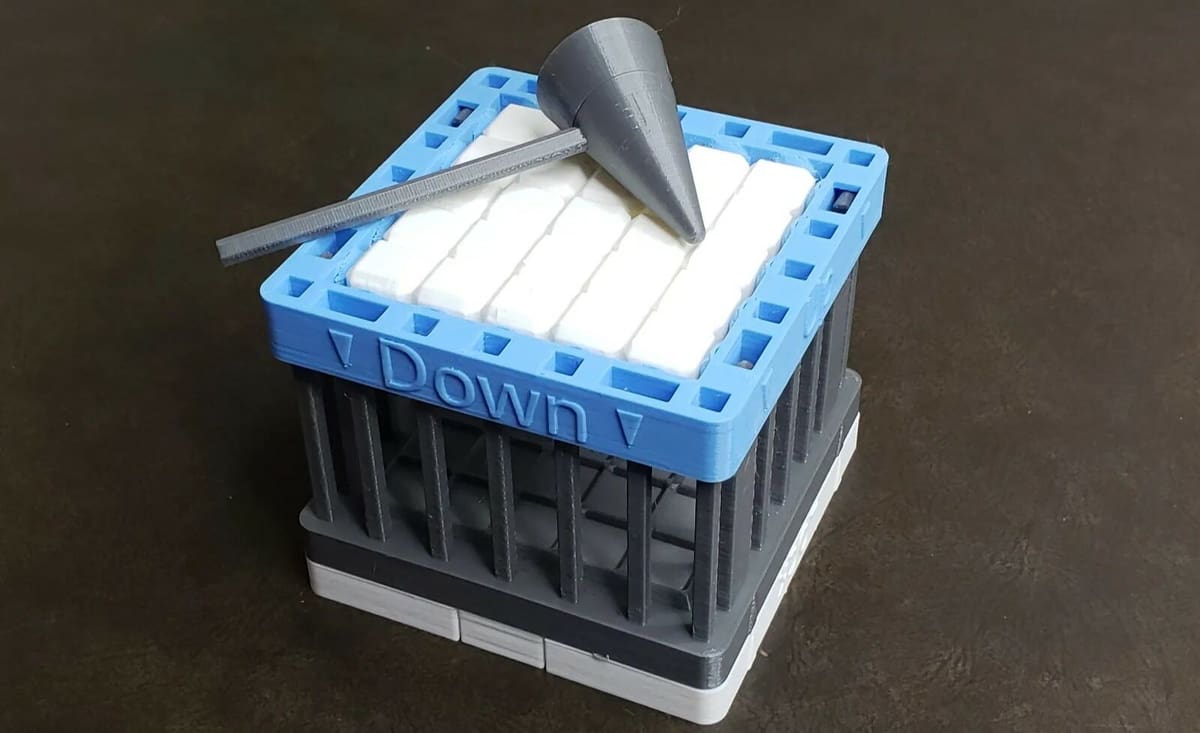
If you haven’t played Don’t Break the Ice before, it’s similar to a 2D version of Jenga. Each player takes a turn removing a block, in this case an ice block with a pick, and the player who causes all of the ice to fall loses!
The game is for up to four players. In order to ensure a proper fit, the designer has included three files with different levels of tightness (loose, medium, and tight) to accommodate printer differences. It’s best to start with the medium size and then adjust accordingly. The designer recommends setting the fan speed to 100% to help solidify the bridging sections in the lid.
- Who designed it? Paca
- How printable/popular is it? This model has around 340 downloads and 6 shared makes so far.
- Where to find it? Printables
Chair-Stacking Game
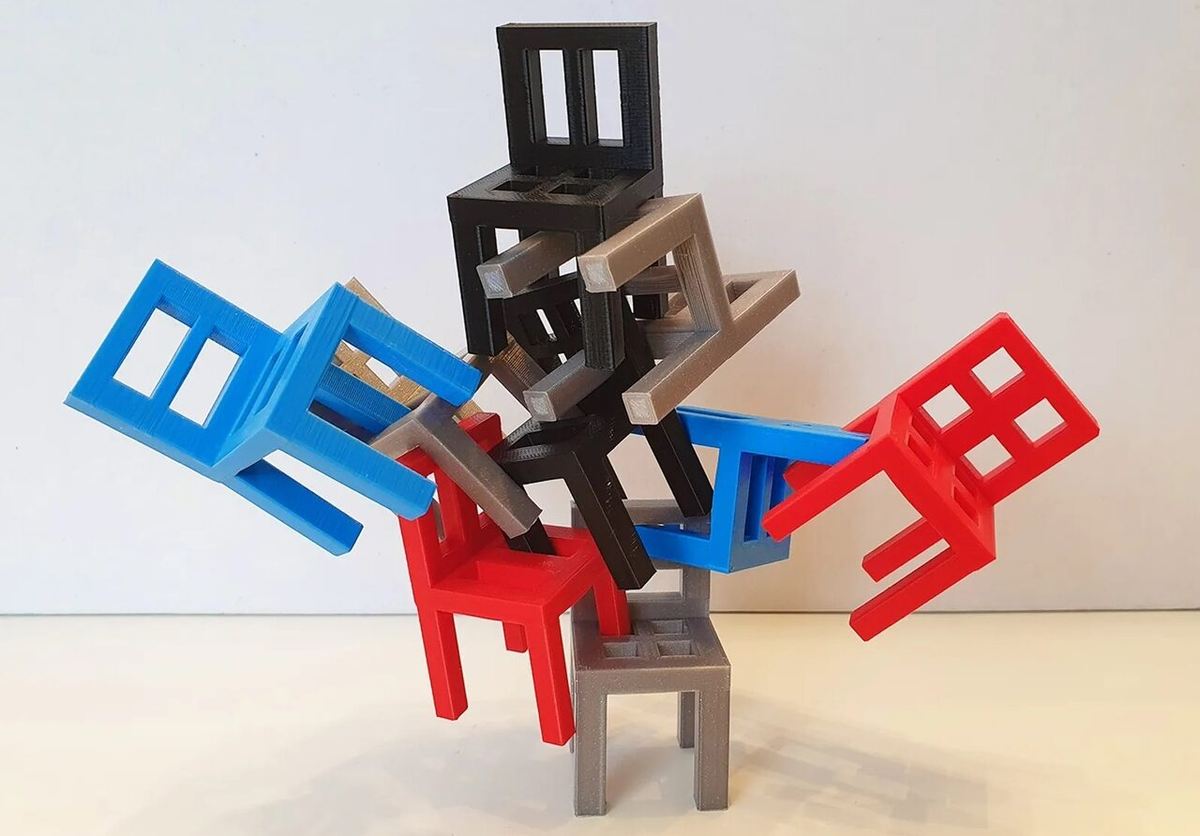
This game is simple enough that it doesn’t need much explanation, but it’s still fun and challenging. Starting from one single chair, players take turns stacking chairs, and the first one to cause the structure to fall is the loser. Chairs have different backrest patterns that offer different ways to stack them.
The chairs need supports but otherwise should be easy to print.
- Who designed it? ThomasH3D
- How printable/popular is it? This popular design has 47 makes.
- Where to find it? Printables
Elastic Football
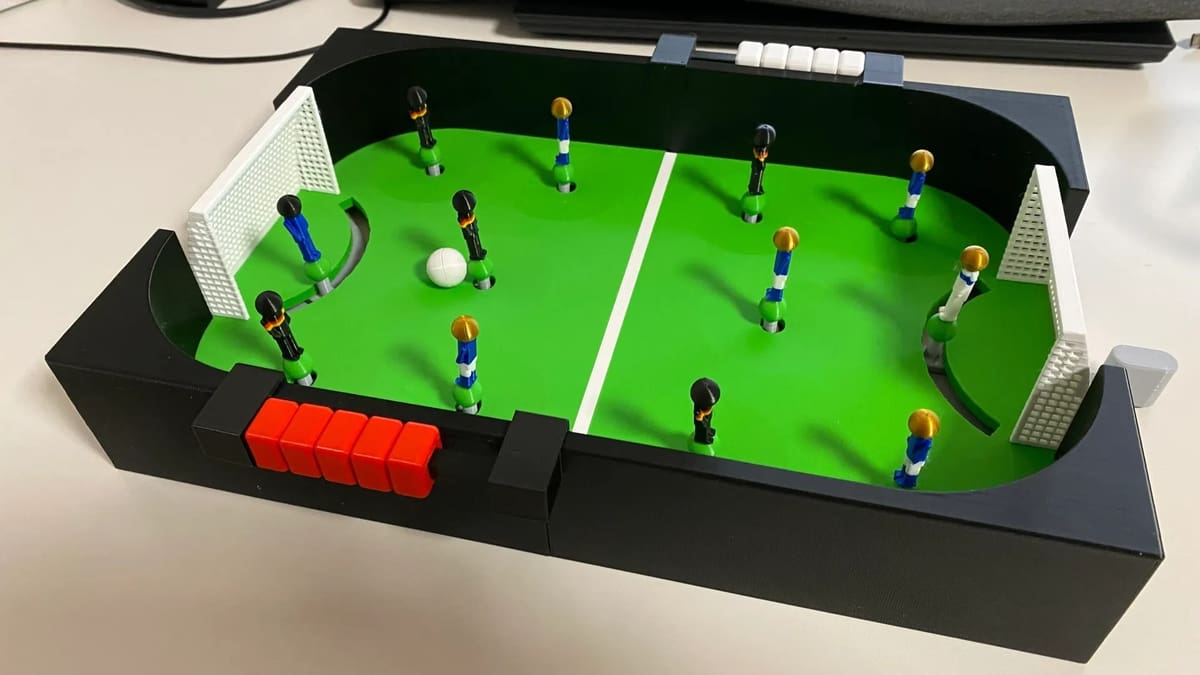
Elastic football is a tabletop game in which elastic rubbers replace the traditional rods used in foosball, but the goal of the game remains the same. The objective is to be the first person to score five goals by shooting the ball into your opponent’s net while defending your own.
The game is made up of several 3D printed parts, including the base, the goalposts, and the players. For successful results, the designer suggests printing the field with a brim to avoid warping and printing the player pieces with 100% infill.
- Who designed it? Wilko_SLO
- How printable/popular is it? With nearly 3,600 downloads, around 900 likes, and 21 makes, this board game is very popular on Printables.
- Where to find it? Printables
Hallway Seej
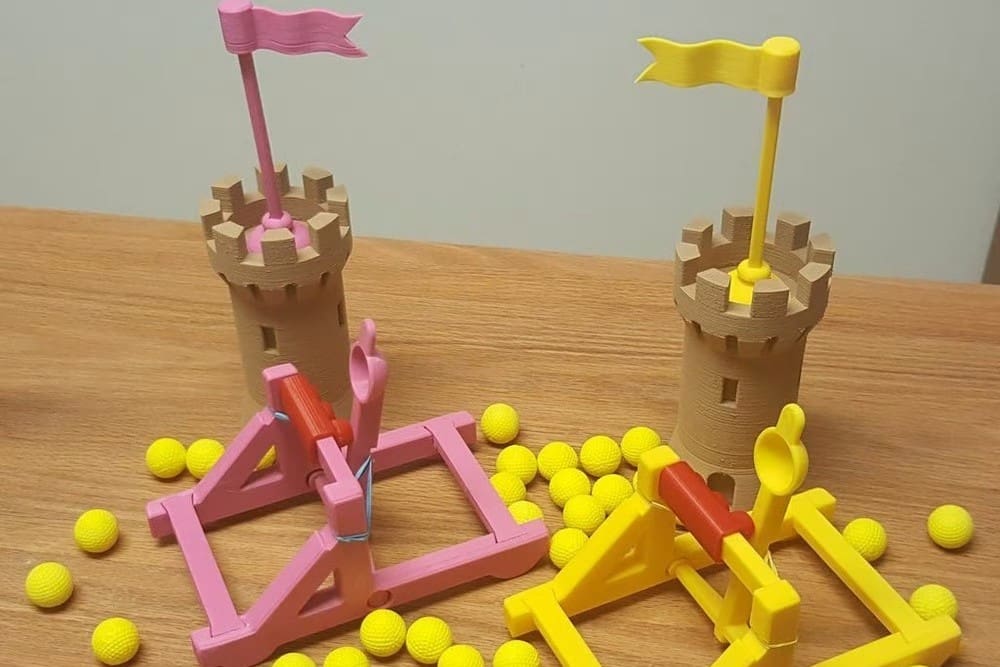
This is an exciting accuracy game that will cause chaos in your corridors. Although this game isn’t on a board, it’s still fun for challenging friends. The objective is simple: the first person to take down the other player’s flag wins. But remember, you may only do so using the trebuchet and balls. (The balls are not included in the model.)
Print these in a less rigid filament; while PLA should work, ABS is likely to shatter under the strain. You’ll also need some rubber bands to power your trebuchets.
- Who designed it? blitzJon
- How printable/popular is it? This original game has nine makes and two remixes.
- Where to find it? Thingiverse
Balancing Game
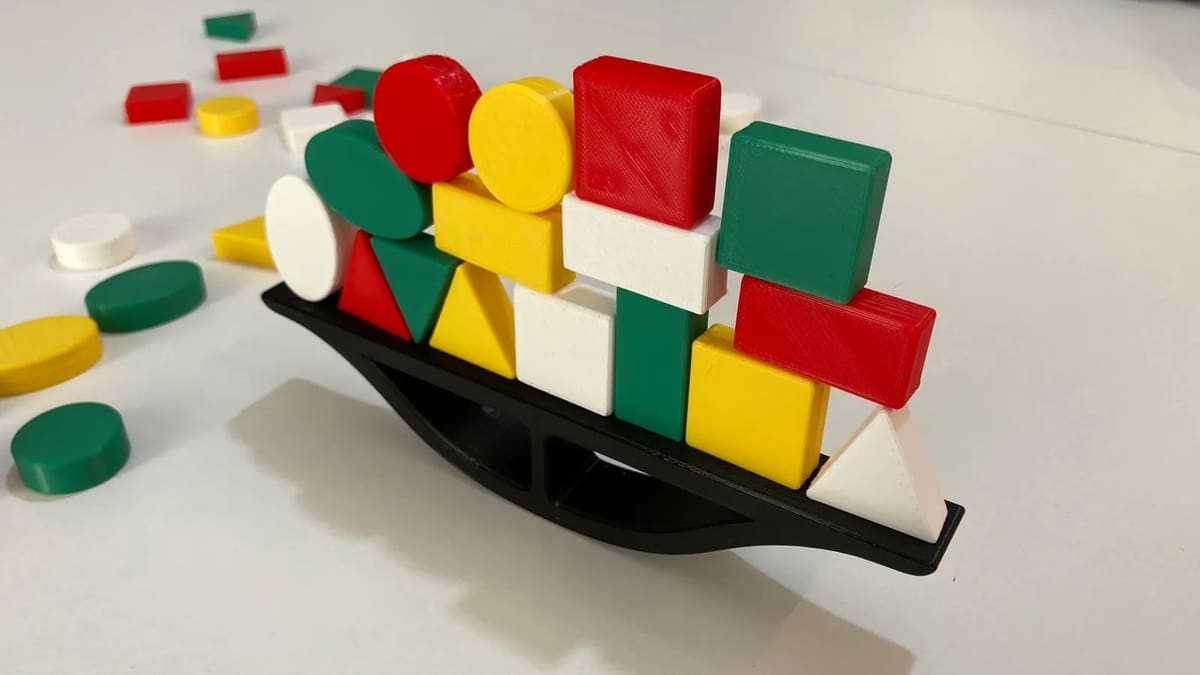
Here’s a reverse Jenga with a twist. Instead of taking blocks off, you have to put them on. Additionally, there are different shapes, so you can be strategic and use what’s easier for you or what will make it harder for others. However, take into account that you’ll have to use all your shapes eventually. How to win? Don’t be the one that makes it fall.
This game is very easy to print because it doesn’t require supports or even different colors, though we think it looks great with a rainbow of shapes. The number of shapes you print is up to you – see how long you can keep the game going!
- Who designed it? DCMake
- How printable/popular is it? This balancing game has 8 makes shared and over 1,000 downloads.
- Where to find it? Printables
Quoridor
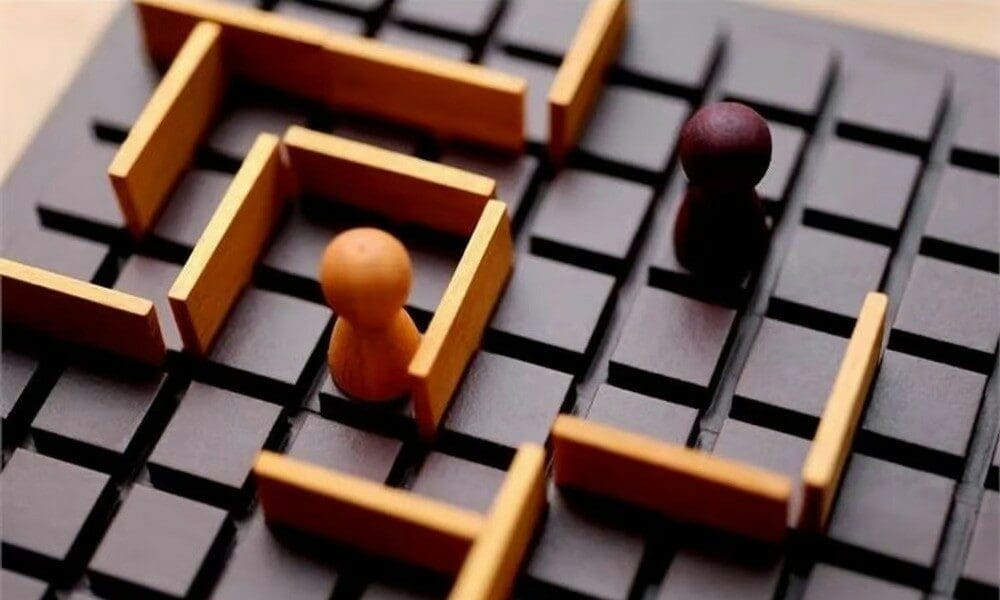
Next up is a new type of maze challenge. Obstacles are placed live during the game, and in each turn, you have to choose between placing an obstacle or moving your pawn. You win the game by reaching the other side before your opponent. You’ll need to block them from reaching your side, but be careful not to block yourself!
The pieces are mostly flat and shouldn’t require supports, so while it may take a while to complete, it shouldn’t be too difficult to print. And if you want to go for a rustic version like the one in the image above, wood PLA will do the trick.
- Who designed it? Ziyay
- How printable/popular is it? 43 makers have shared prints of this strategy game, and they report that it was an easy print.
- Where to find it? Printables
Table War
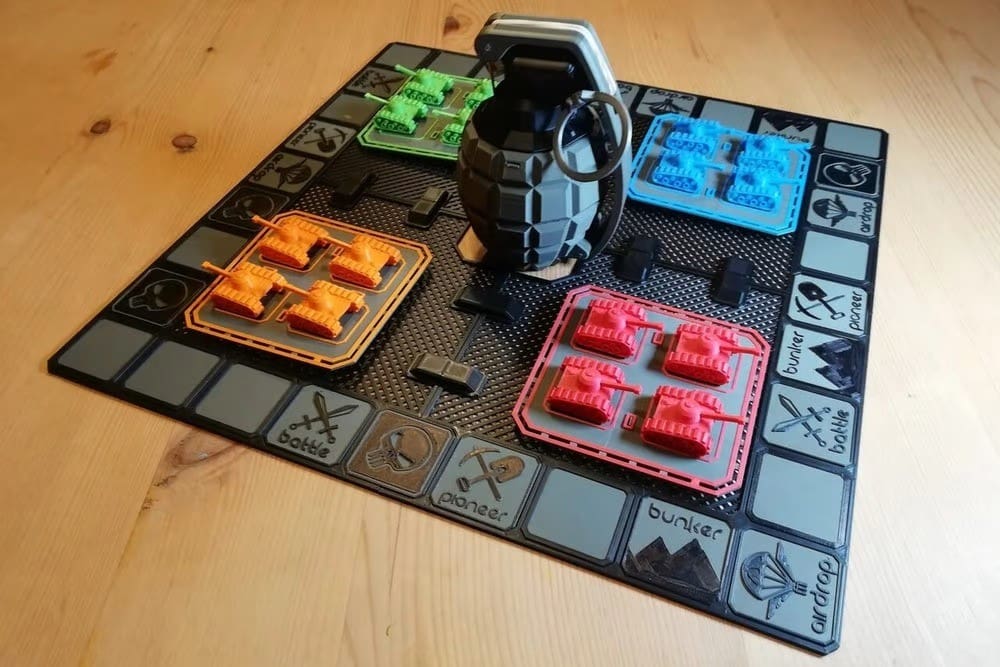
This game was actually the winner of the “Tabletop Games and Puzzles” design contest by Printables. It’s similar to Pachisi, but each square on the board has a different theme. For example, when a player lands in the battle square, the player has to pull the safety pin of the grenade and pass it around players until it “explodes” (which will simply be a sound), and the loser has to put their tank back in the base.
- Who designed it? peaklin
- How printable/popular is it? This model has three makes. In addition to the 3D printed parts you’ll need an Arduino Nano and some other additional components. But no soldering is required!
- Where to find it? Printables
Spin-Offs
The following board games are spin-offs of popular games or series!
Pac-Man
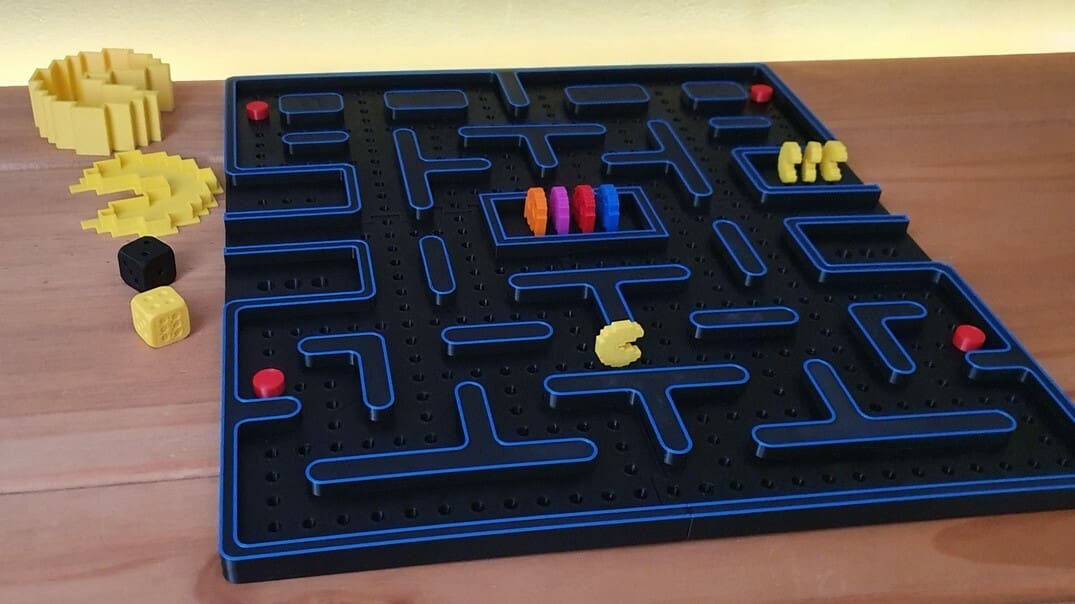
The Pac-Man board game is a thrilling and competitive two-player game perfect for those looking to relive the classic arcade game in a tabletop format.
The game involves one player taking on the role of Pac-Man, while the other player assumes the role of the ghosts. The goal is to collect all four red pills without being captured by the ghosts. Pac-Man can also acquire power pellets and other superpowers to help him clear the board.
You may have to split the board and print it in multiple parts, as the total board size is 372 x 336 mm. Additionally, the creator suggests printing all the parts with a 0.25-mm layer height, two shells, and 10% infill.
- Who designed it? lorinczroby
- How printable/popular is it? This arcade-inspired board game has around 1,200 likes and 7 makes.
- Where to find it? Thingiverse
Prusa Balance Game
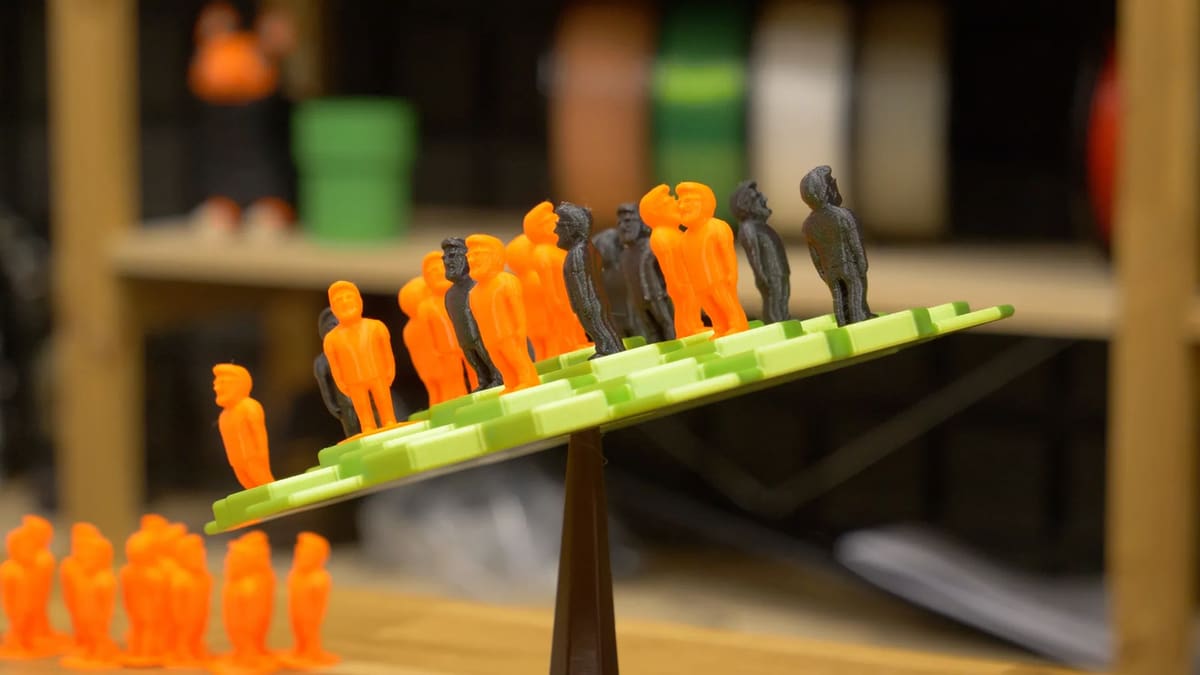
You may have played similar games growing up, trying to balance cute animals on top of a toppling tree. This version of the classic balancing game gives you the option of using either Jo Prusa or a baby dragon as your character of choice, though plenty of alternative characters can be found in the many remixes.
All files for this game were designed to print without supports. You’ll find plenty of shared makes that you can browse through for inspiration on filament types and color combinations. There’s even a travel case remix should you want to take this game with you when you leave the house.
- Who designed it? DavidWarboss
- How printable/popular is it? Over 13,000 people have downloaded this board game. You will find a staggering 238 makes and 46 remixes of this model as well.
- Where to find it? Printables
Star Trek 3D Chess
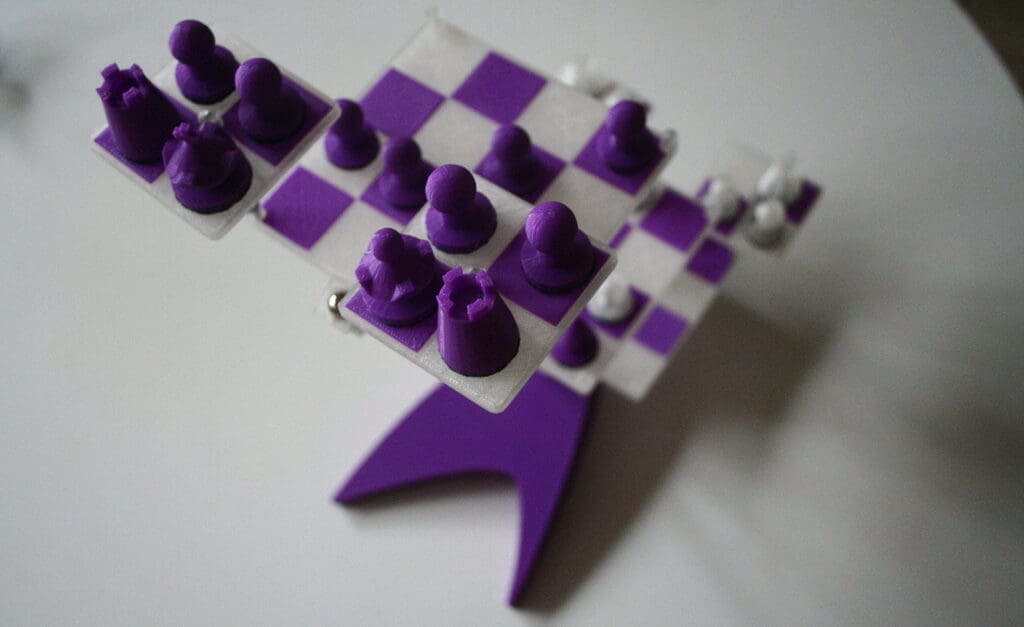
If chess is just too easy for you, take it up a notch with a 3D version. This one is almost a classic, and even if you haven’t watched Star Trek, you’ve probably seen this 3D chess reference in other popular shows like The Big Bang Theory or Zoey 101.
There are three main boards, which are 4 x 4 grids, and to complete the other four rows, you have to use “attack boards” which are 2×2. After printing, you’ll need some Ø1/4″ threaded rod to fit everything together.
- Who designed it? alan_one
- How printable/popular is it? This is a popular model with 18 makes and 1 remix. The complete instructions are available online.
- Where to find it? Thingiverse
Save the Last Unicorn
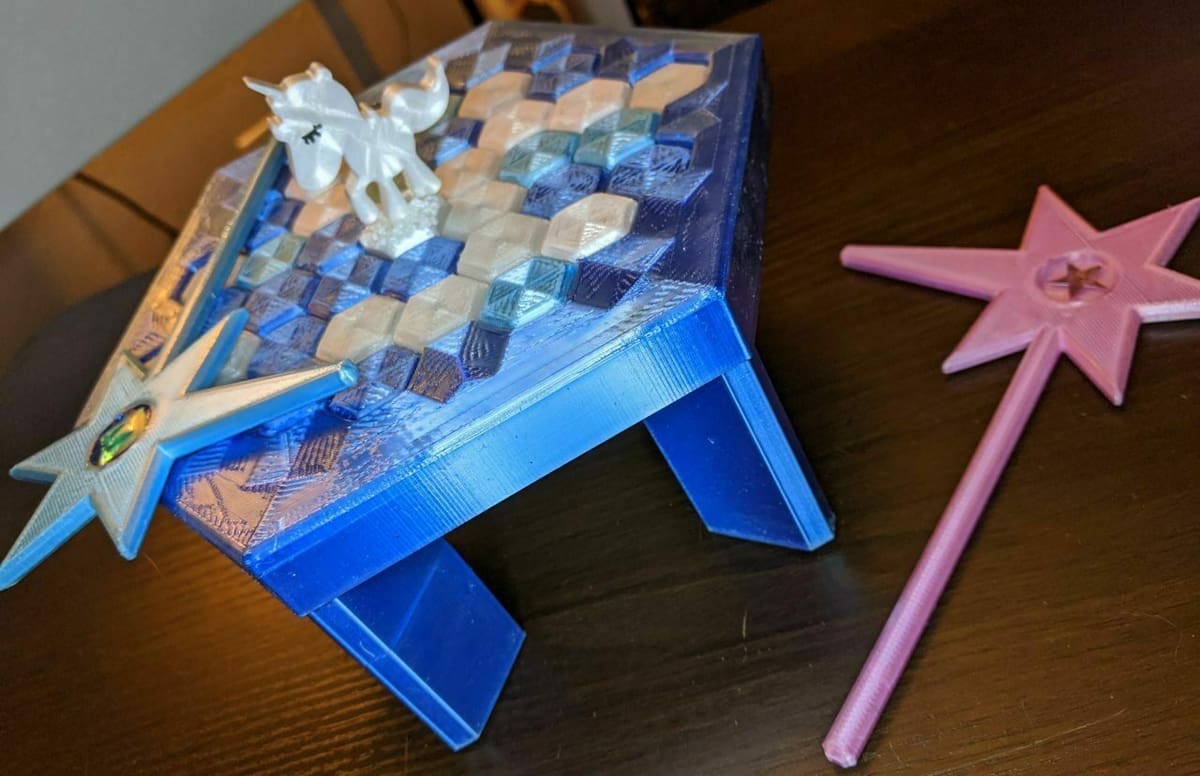
In this spin-off from the classic game Penguin Trap, you don’t have to save a penguin from the melting of the icebergs, but instead a unicorn from an imaginary threat. You could say the game seems less ominous this way. You have to chip the stones one at a time, trying to keep the unicorn from falling. The first player to make it fall is the loser.
You need to print at least 36 stones, as well as a wand, a frame, a unicorn (of course), and a unicorn stone. If you want to keep the icy backdrop, transparent filament would be a great way to achieve such an effect.
- Who designed it? DorAndy
- How printable/popular is it? This model has nine makes and three remixes on Thingiverse.
- Where to find it? Thingiverse
Cyvasse

This is the game from the universe of Game of Thrones, created by George R.R. Martin, and brought to life thanks to this maker. The game doesn’t have a strict set of rules, so you can play it however you like, which makes it interesting because different people may find ways to make it more challenging.
George R.R. Martin suggests playing it like a mix of chess, Stratego, and Blitzkrieg, but the creator of this model also includes his own version of the rules.
Some parts need supports, and the smaller the layer height, the more details you’ll be able to capture.
- Who designed it? dutchmogul
- How printable/popular is it? This throne-conquering model has 35 makes and 16 remixes.
- Where to find it? Thingiverse
Star Wars Seven Stones
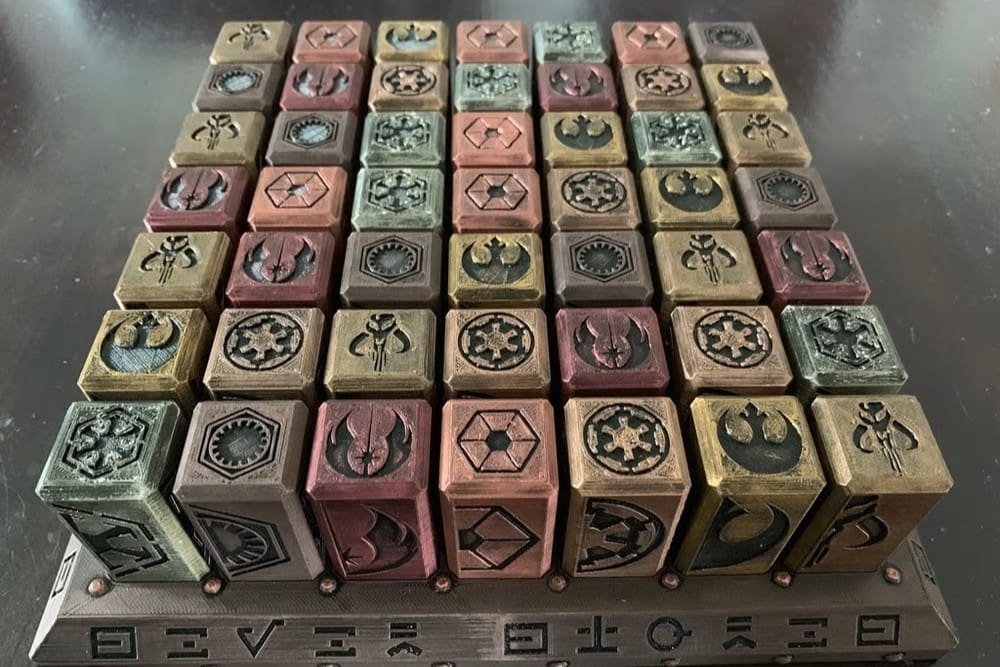
This is an interpretation of an app-based game called “Sevn”, but in this version, you’ll have to battle between different powers in the Star Wars universe. Use the Force and all your strategic capabilities to win this game.
If your printer isn’t large enough, the boards can be printed in parts and assembled with bolts and glue. The blocks also include dowel joints to keep them fixed to the board while playing.
- Who designed it? Hiob
- How printable/popular is it? This Star Wars-themed game has eight makes and two remixes. The creator recommends PLA as a good filament choice.
- Where to find it? Thingiverse
Classics
We couldn’t put together a list of board games without covering the classics. From chess to Settlers of Catan, these are the iconic games that we all remember.
Infill Jenga
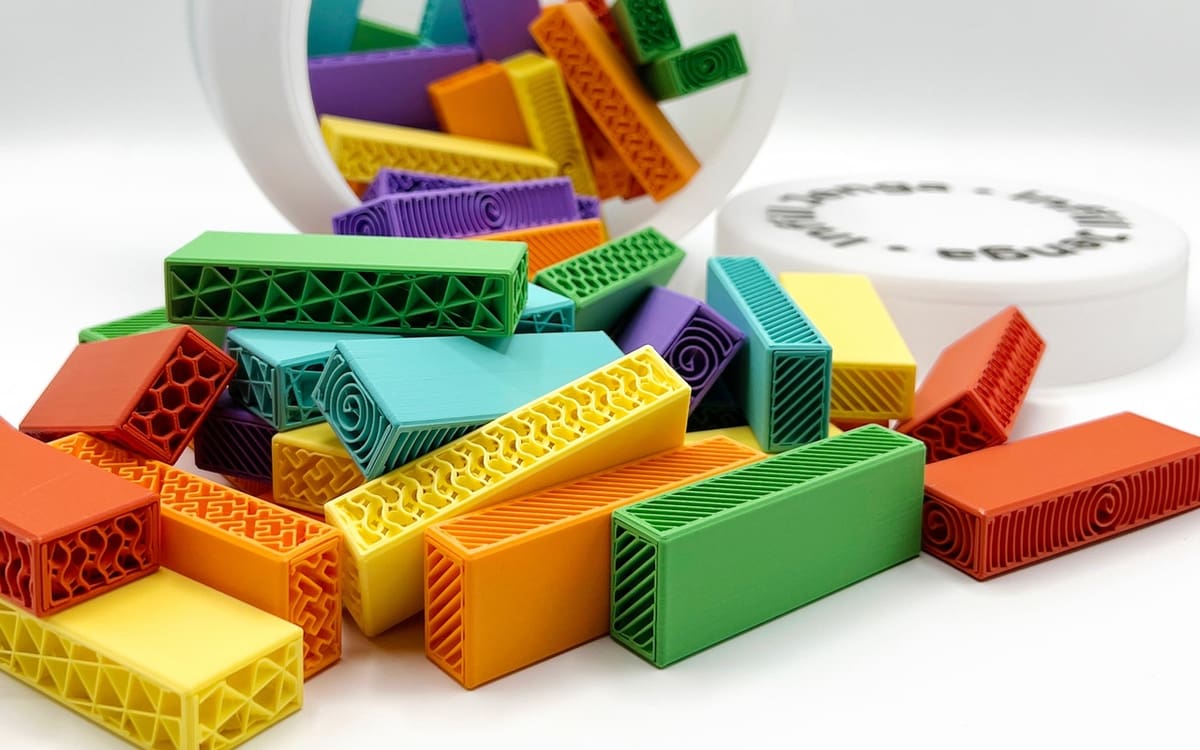
Enjoy the classic game of Jenga, with a slight twist. These pieces each print with different infill patterns and no outer walls, allowing you to see the unique patterns of each piece as you play. This makes an already fun game that much more interesting.
The designer includes 3MF files to print out similar blocks to their own. Vase mode is recommended in order to keep the file from creating a solid block. Consider printing some blocks with denser infill patterns to add a bit of weight to them for interesting choices in the balancing game.
Mahjong Tile Set
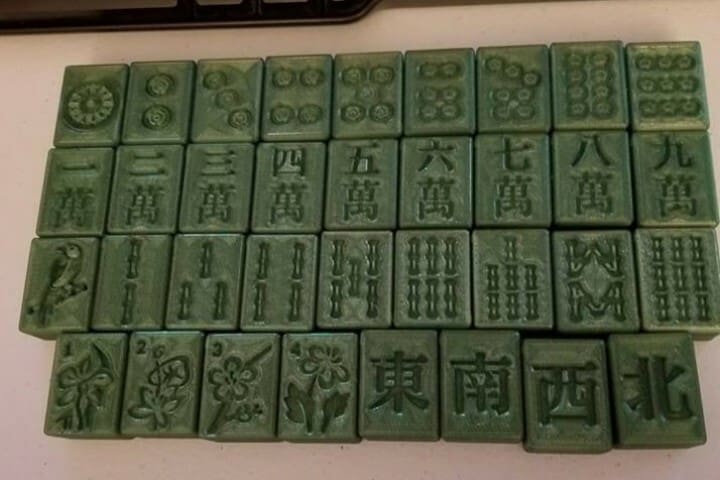
The classic four-player game is a great project to print and play with friends. While these 3D printed tiles may not be as colorful as the other versions of the game, they still come out with a unique appeal.
Print the debossed side facing up and refrain from ironing, as it will spill filament into the tile faces. To increase visibility, a layer pause and filament change along the first layer of the deboss might help. You could also paint your tiles to really make the symbols pop.
- Who designed it? twiesner
- How printable/popular is it? This model has 1 make, over 930 downloads, and over 140 likes on MyMiniFactory.
- Where to find it? MyMiniFactory
Settlers of Catan
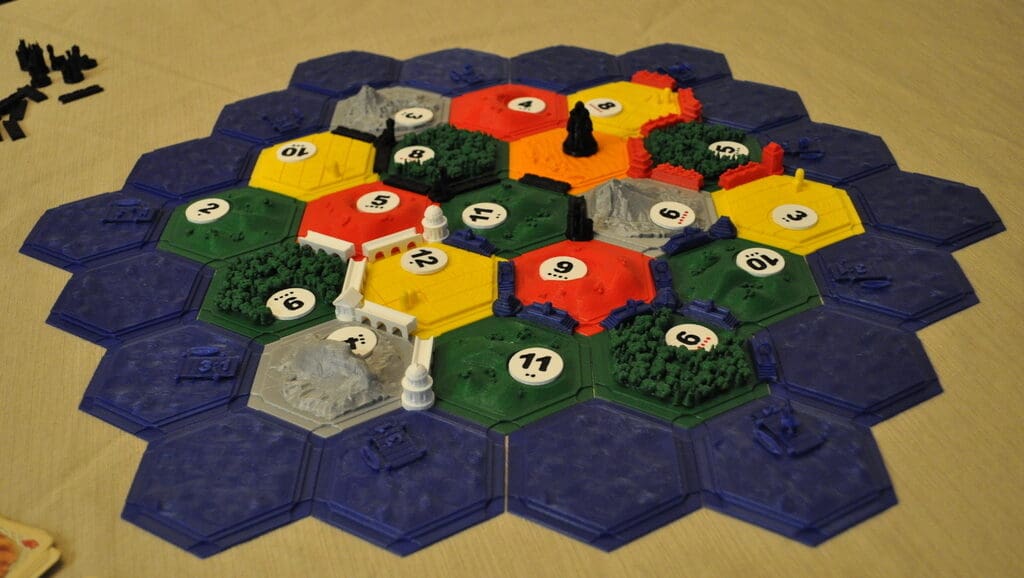
No one takes their strategy game as seriously as a Settlers of Catan player. In this game, players have to collect resources to build roads, expand cities, and conquer territory. The board will vary from game to game, and with so many types of tiles, it’s a great choice to 3D print.
This set is a full recreation of Settlers in 3D. The only thing you’ll need to bring is the cards, but if you don’t already have a set, these can be bought separately.
- Who designed it? trevorclarke
- How printable/popular is it? This board game has 32 makes and 12 remixes. You need to print most parts several times, so the creator has provided a complete list.
- Where to find it? Thingiverse
Otrio
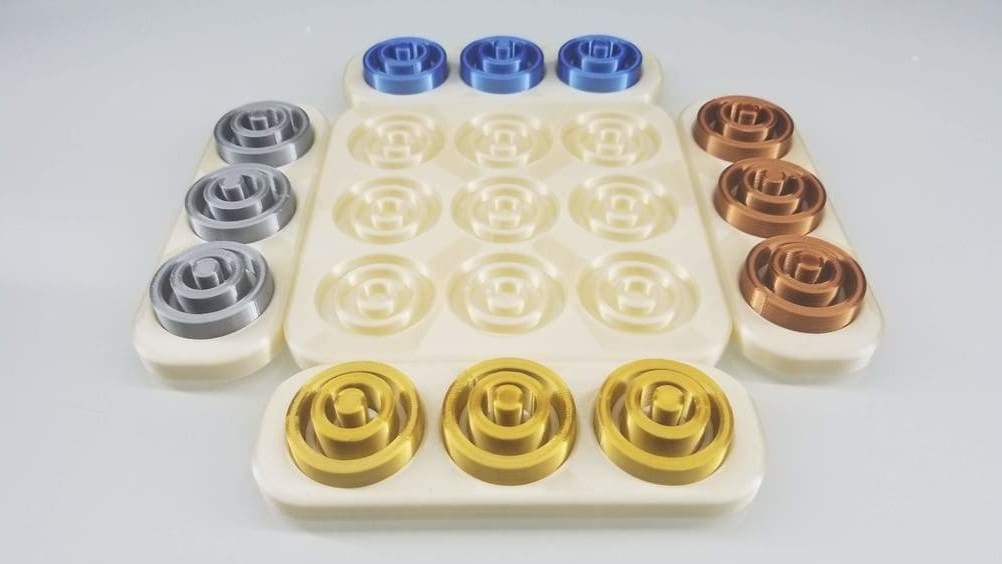
Otrio is a game that can get quite complicated, especially with so many colors on the board at one time. That’s what makes it so interesting. This 3D printed recreation allows you to choose what colors you want for the different sets of rings.
The board itself prints in five different pieces, making it easy to assemble and disassemble for storage and travel. This also makes the board easy to print on smaller print beds. One maker has even printed the board pieces in different colors to keep track of who is who.
- Who designed it? Erik2173
- How printable/popular is it? Over 7,000 downloads and 7 makes show that this is both a popular and printable choice.
- Where to find it? Thingiverse
Hive
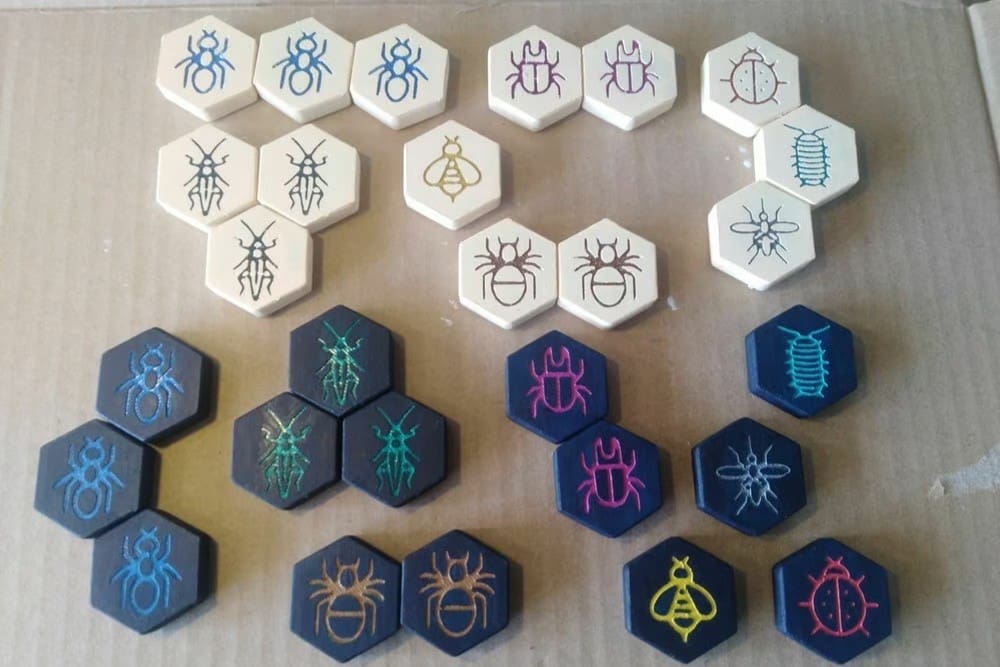
The objective of this game is to surround the other player’s queen bee tile, effectively capturing and taking over her hive. Each bug type has specific moves they can perform, like in chess. But, in contrast to chess, there’s no board, so each game can take on a different form, and you never know what’s going to happen.
This set is all flat pieces so it doesn’t need supports, and you can add some color with a dual-extrusion 3D printer.
- Who designed it? Gigbrinus
- How printable/popular is it? This model has 52 makes and 13 remixes, so a lot of people are enjoying their new games!
- Where to find it? Thingiverse
Sternhalma (Chinese Checkers)
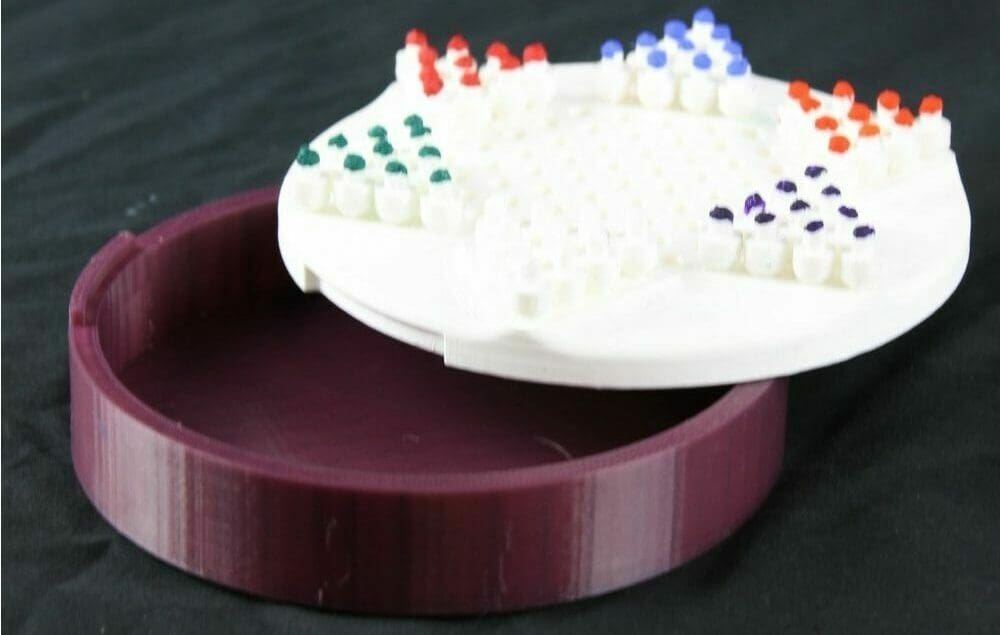
Did you know this game is actually German? It’s believed that the name “Chinese Checkers” originated in the US as part of a marketing strategy for the game.
To play, you’ll need 60 pegs printed in total, 10 for each of the 6 colors. And as the creator does, you can print them all together and then paint the top of the peg. The board also includes storage for the pegs, so you don’t risk losing any!
- Who designed it? Pandas
- How printable/popular is it? This board game has 430 downloads. It might be a good idea to use brims for the pins, and you can print many at once to save time.
- Where to find it? MyMiniFactory
Troke: Castle Chess
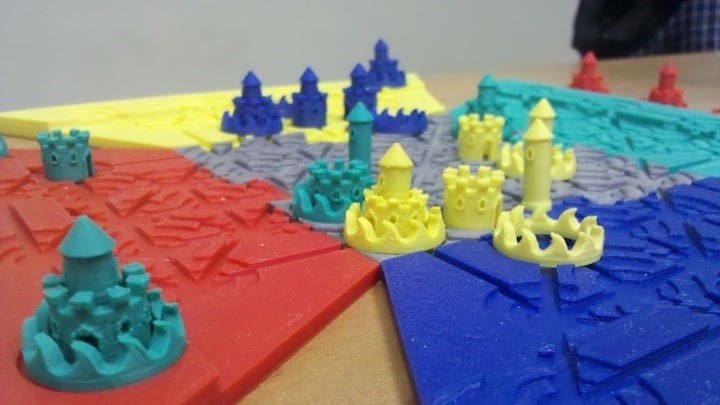
This 1956 game is out of print, but maker joealarson brought it back to life with this 3D printed rendition. The game pieces have received some updates from the simple designs of the original game, with detailed castles and a less confusing board.
The board itself is designed to be printed on medium-to-large print surfaces. Luckily, if you don’t have a printer large enough to print the board, the designer has also included images that you can print out on paper instead.
- Who designed it? joealarson
- How printable/popular is it? So far, this game has over 2,100 views and 7 likes on Pinshape.
- Where to find it? Pinshape
Ludo
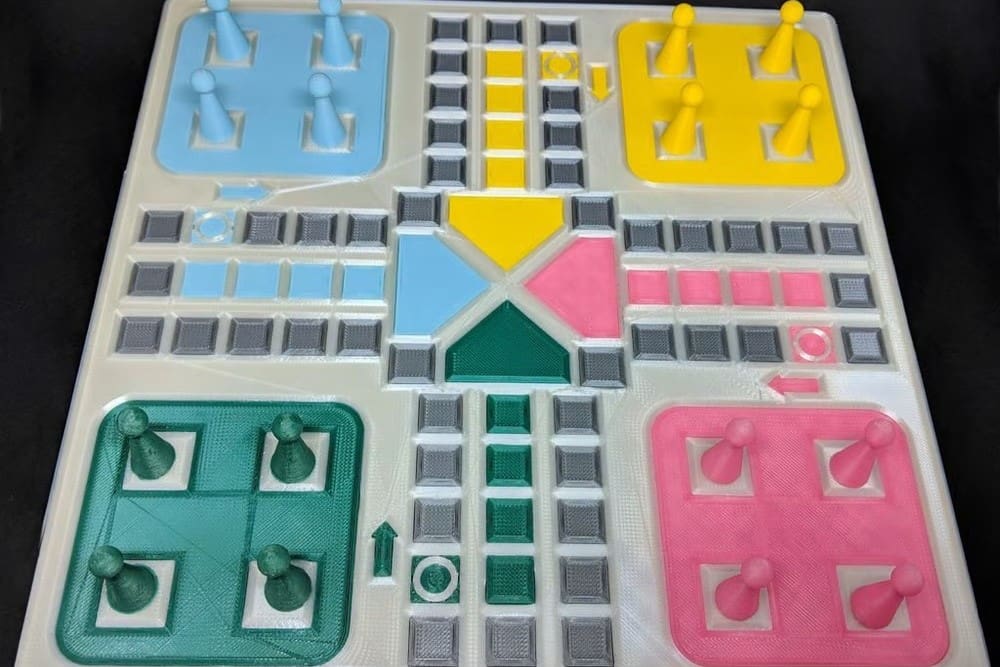
The perfect way to start a fight with friends is to play a game of Ludo. You know that moment when your friend can choose to skip you, but they end up stopping in your tile and killing your pawn? That’s not fun.
This game is derived from the Indian game Pachisi. The mechanics are very simple: take your four pawns across the board and into the center before any of your opponents!
- Who designed it? fchamone
- How printable/popular is it? This model has over 80 likes, though no makes have been shared yet. You can print the parts separately, in different colors, and then fit them all together.
- Where to find it? Thingiverse
Dog & Tock
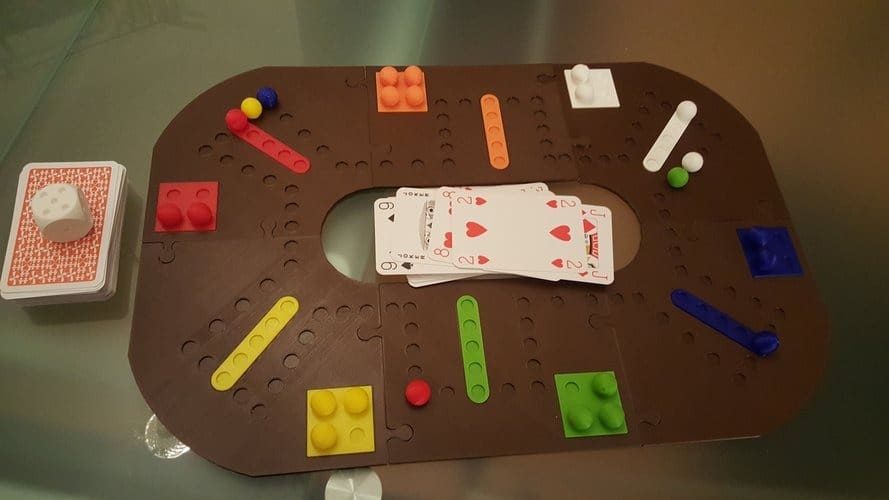
Similar to Ludo and Pachisi, in this game you race your pawns all the way across the board and onto the center. In this version, you can add more pieces to have up to six players.
Dog and Tock are different games, but they use the same board and change only in some rules, so you can decide which one you’re feeling up to that day.
- Who designed it? tigerklaue
- How printable/popular is it? This board game has 13 likes and 14 collects. Take into account your printer’s dimensional accuracy to make sure the puzzle pieces fit adequately.
- Where to find it? Pinshape
Chess
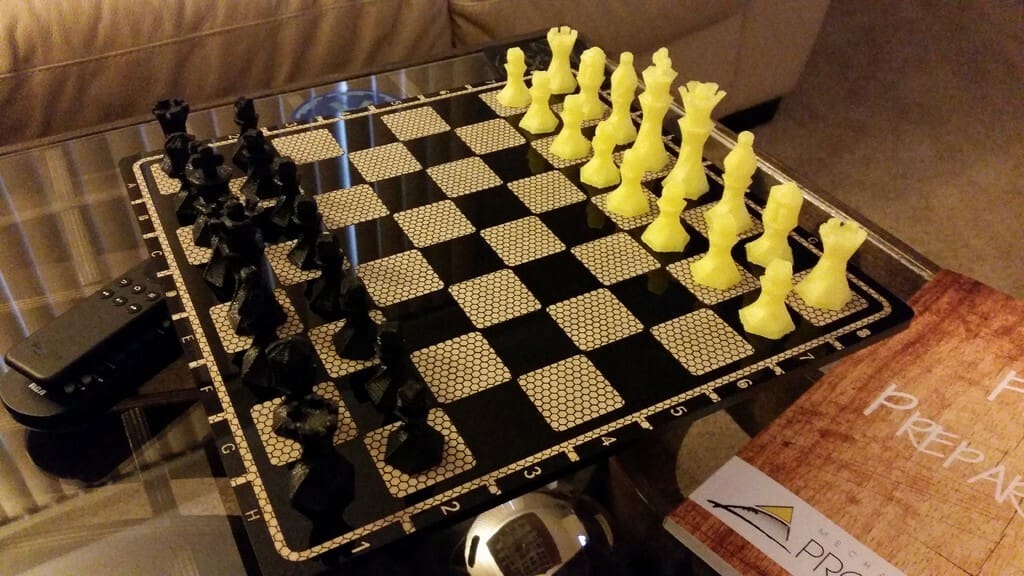
When it comes to chess, who can’t say “been there, done that”? And despite its traditional rules, it’s as popular as ever – just ask The Queen’s Gambit.
This beautiful chess set uses hexagonal twisted bases and 3D printing to make the game look elegant, yet it’s got a fun side to it since it’s 3D printed. While the maker laser cut their own board, maybe you’ve already got one lying around.
- Who designed it? Tronn
- How printable/popular is it? Seven people have printed this chess set, which includes the chess board files.
- Where to find it? Thingiverse
Quarto
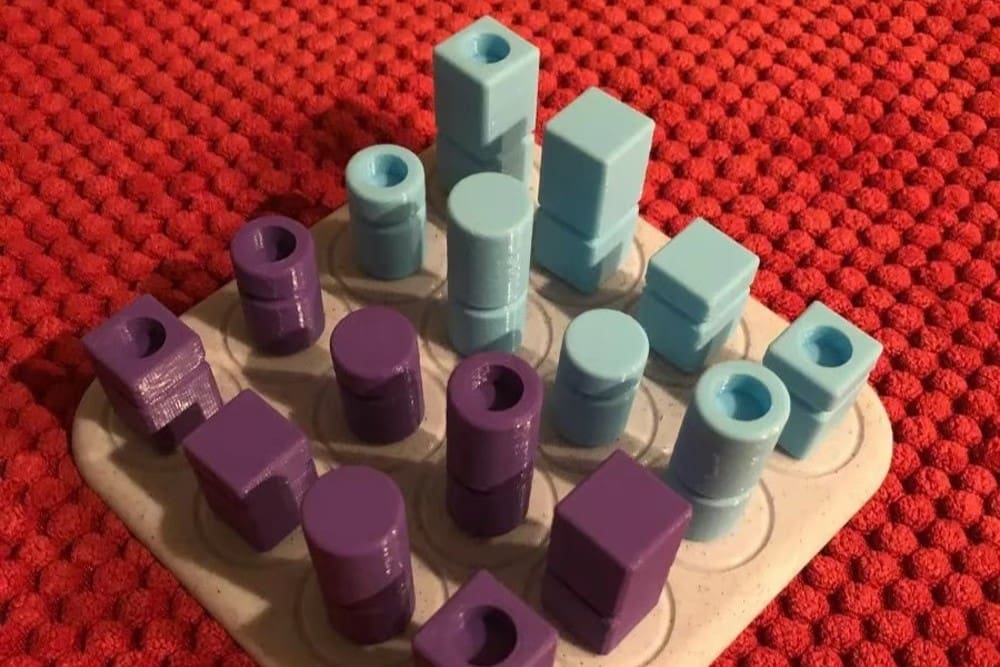
This is a game about detail, so be ready to focus on it. You win the game by creating a four-in-line of pieces that all share a common factor. You have to notice and complete a pattern before your opponent. It can be the color, the shape, the hole in the middle, who knows?
You’ll need to print two sets of eight pieces in contrasting colors, as well as the board.
- Who designed it? rhynes
- How printable/popular is it? This game has five shared makes. All models are easy to print and don’t need supports.
- Where to find it? Printables
Checkers
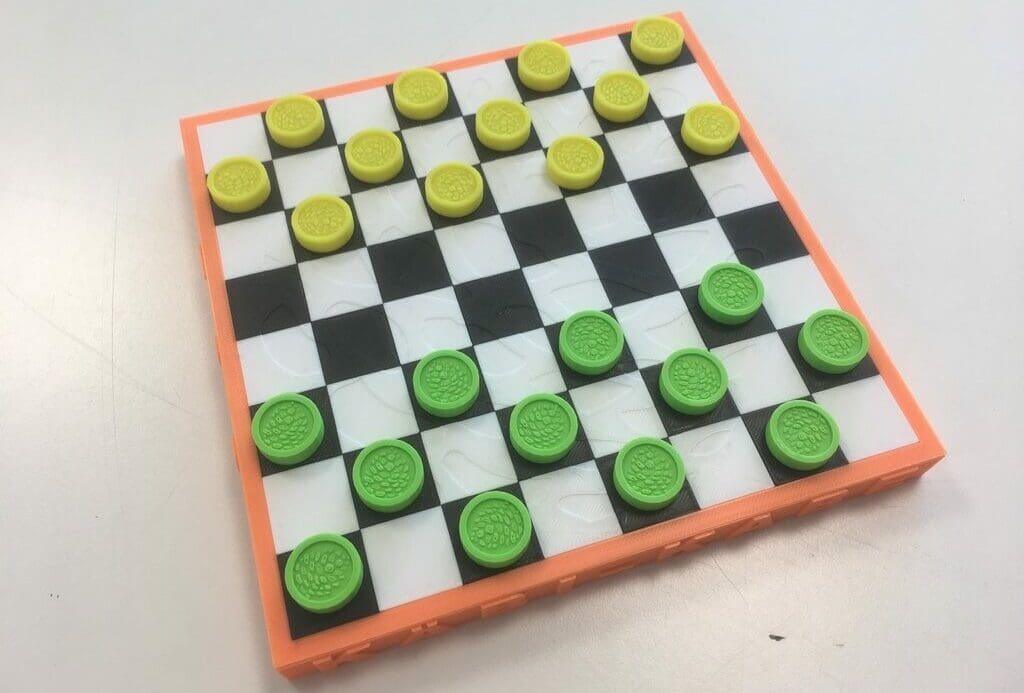
While this is a slightly less complicated version of chess, don’t get overconfident – you’ll still need your brain to defeat a worthy opponent. Checkers is also played between two players, but the pieces can only move diagonally and can only kill by jumping diagonally in front of another piece. Notice that the pieces must be placed in only one color on the grid.
The pieces all have a pine cone design that adds a nice level of detail. Watch out for warping when you print the board since it’s a wide, flat surface that could cause some problems.
- Who designed it? Simakrima
- How printable/popular is it? This checkers model has over 2,300 downloads, and a make has been shared in fun shades of pink and purple.
- Where to find it? Thingiverse
Rota
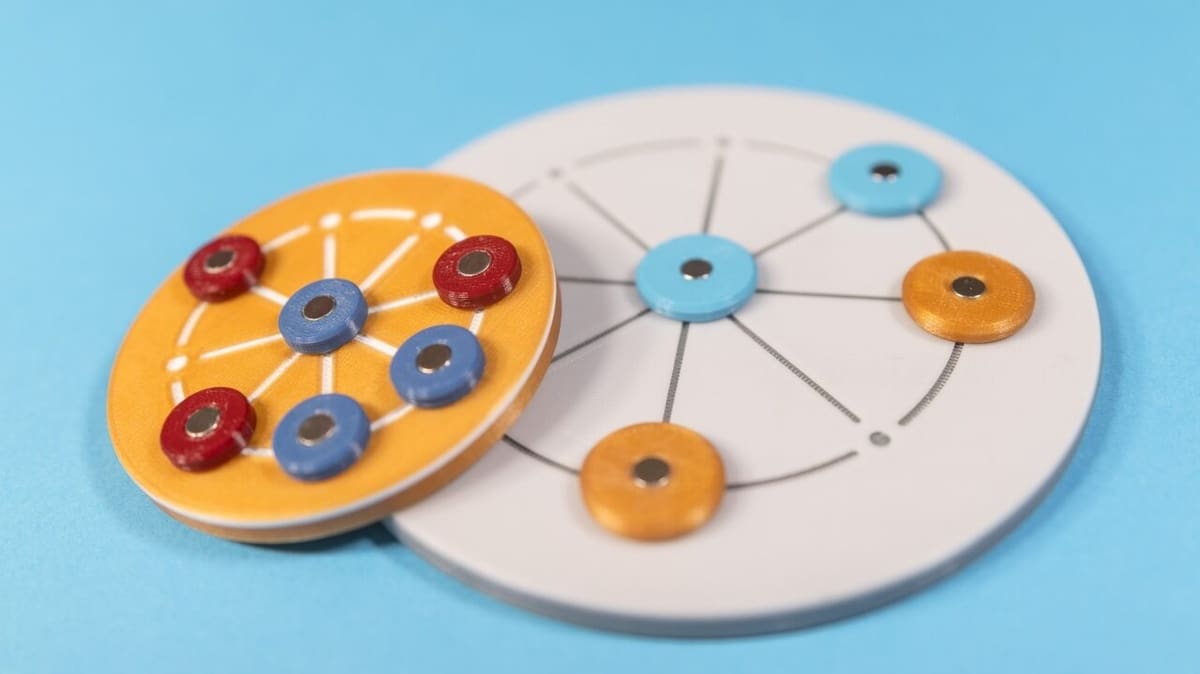
Rota is like an advanced Tic-Tac-Toe, and you can play it with anything, from coins to some rocks, or in this case, some 3D printed parts. Each player gets three pieces, and you take turns placing each on the board. After all the pieces are placed, players take turns moving them along the adjacent lines until someone achieves three in a row.
The designer printed this top-side down and swapped the filament at 1 mm high to get the two-color effect. If you use small magnets, it’ll be easier to attach and move around the pieces.
- Who designed it? MakeAnything
- How printable/popular is it? This game has over 1,200 downloads and 5 community prints.
- Where to find it? MyMiniFactory
Gobblet
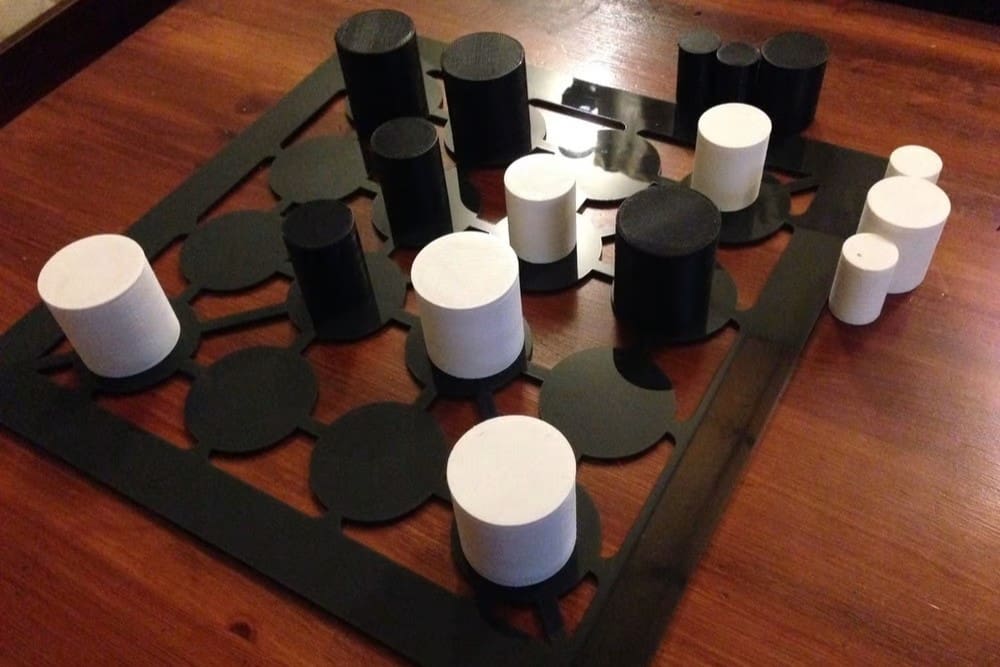
This game is another different, more advanced version of Tic-Tac-Toe. In this case, you’re aiming to get four in a row, starting with the smallest pieces. However, bigger pieces can eat the smaller ones, so you have to think about how to slow down your opponent while preventing them from slowing you down.
As with many of these games, you’ll need at least two filament colors to differentiate the players’ pieces. None of the parts should need supports.
- Who designed it? PKitz
- How printable/popular is it? This model has one make shared so far and one remixed game board.
- Where to find it? Thingiverse
Backgammon

A good old classic game of backgammon, a game that younger generations might have only seen in old PC games, not in real life! Print your own set to bring backgammon back into the real world.
This game is a combination of strategy and luck. After all, a bad dice roll could be your downfall. The design uses magnets to keep the pieces orderly on the board, but the author warns that the small magnets and other parts could be a risk for young children.
- Who designed it? Modellaner
- How printable/popular is it? This game of backgammon has two makes and a scaled-up remix.
- Where to find it? Thingiverse
Scrabble
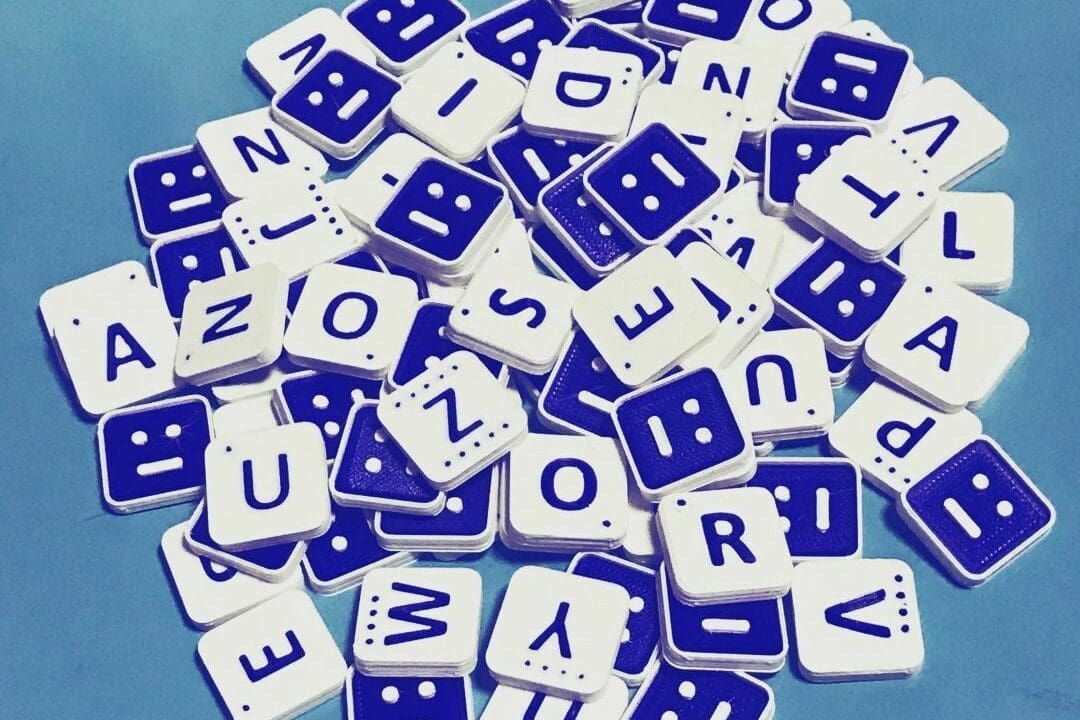
Does Bizjet count as a word, or not?
By printing your own Scrabble tiles, you’ll never run out of words to make up. Or you can even create your own game from scratch by printing a full set and board instead of buying it. Just remember to print the correct number of tiles per letter to keep the game faithful to the original.
- Who designed it? sparkroom
- How printable/popular is it? This model has been downloaded over 570 times already. The designer used dual printing to achieve the color contrast in the letters, making them easier to see.
- Where to find it? MyMiniFactory
Travel
Finally, we have some travel sets for both classic and original games. These are miniaturized or pack up neatly into a carry case for easy transportation!
Coin Game
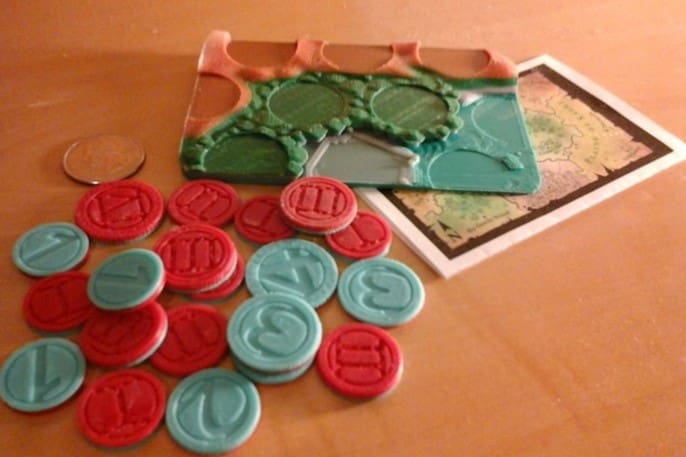
This pocket-sized game uses tokens no larger than coins as pieces that are played on a credit card-sized game board. The designer has created both a game board and a separate file for the coins.
Using filament changes at different layer heights, you can differentiate the zones on the card by color-coding them. The coins themselves have both numbers and Roman numerals on either side for convenience. Printing these sides in two different colors is an easy way to make them more apparent during gameplay.
- Who designed it? joealarson
- How printable/popular is it? This small game has been viewed over 5,000 times and is a part of 8 collections on Pinshape.
- Where to find it? Pinshape
Focus

Focus is a strategy-based board game you can play with a single opponent. This game’s 3D printed version is a scaled-down and portable re-imagining of the original.
You play the game on a square board, and each player has a set of colored pieces they use to try to capture their opponent’s pieces. The game is won by capturing all of your opponent’s pieces or placing your pieces in their starting position.
The maker recommends printing the board and pieces with two different colored filaments for each player, as well as with a layer height of 0.2 mm and an infill of 15% or less.
- Who designed it? tszawkalo
- How printable/popular is it? Even though there are no makes of this model yet, you should be able to print it with the help of the designer’s print settings.
- Where to find it? Thingiverse
TARDIS Run
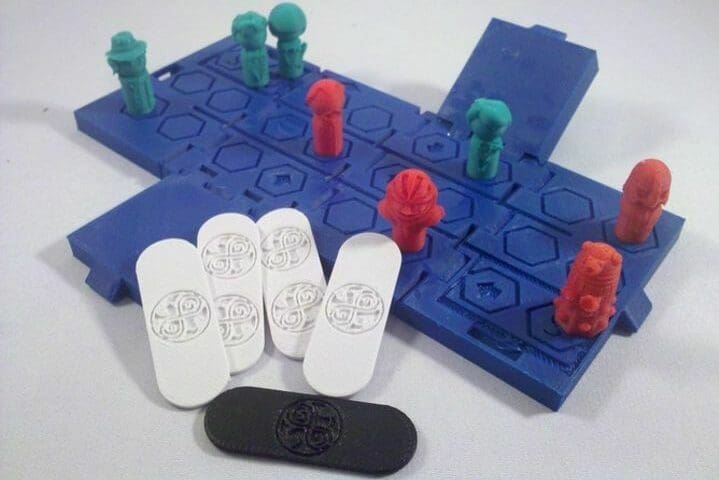
This game takes inspiration from others like backgammon and an ancient Egyptian game called Senet. The Doctor’s opponents are trying to steal the Black Scrolls of Rassilon, but you have the assistance of previous regenerations of the Doctor to beat them to it.
The board is actually print-in-place (if you have a large enough build space) and is assembled with hinges. There’s also a version that prints in parts if you have a smaller print bed.
- Who designed it? joealarson
- How printable/popular is it? This model has over 170 likes and 79 collects. The full rules for the game are supplied so it should be easy to print and play!
- Where to find it? Pinshape
Upshot
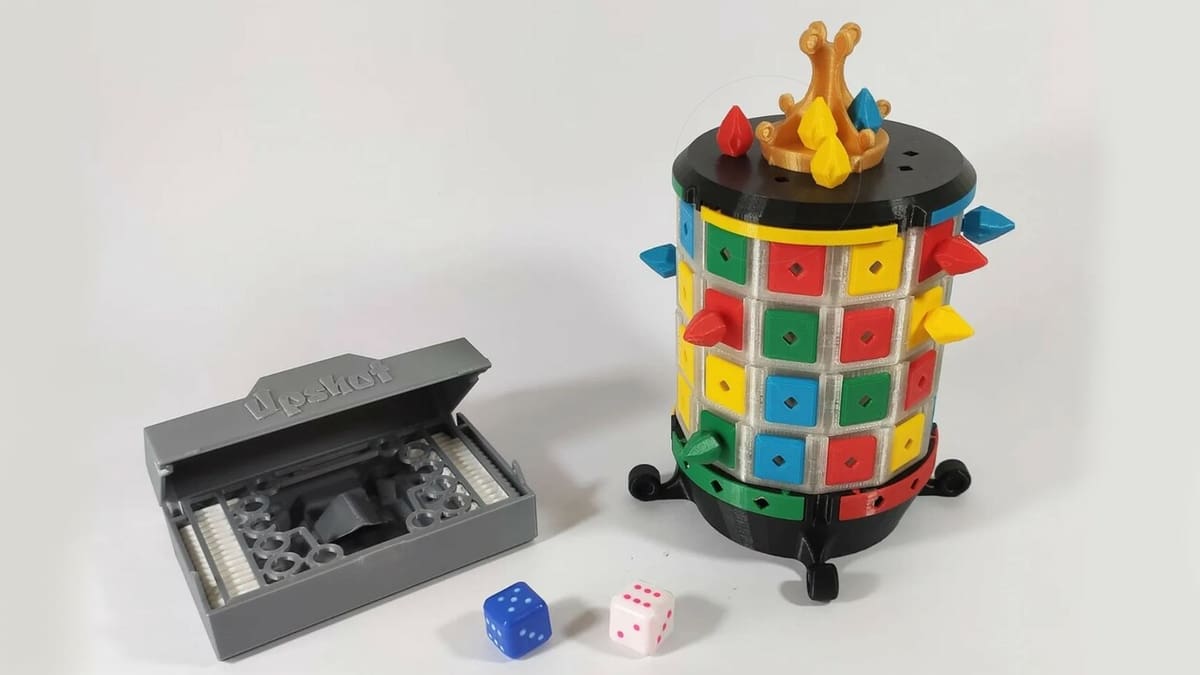
Upshot is an original game with 3D printed pawns that move from the bottom to the top of the board, with the goal of securing a position on the throne. The game combines the strategy of chess with the luck-based gameplay of Ludo, making it a hybrid game that is both challenging and fun.
The board is made up of individual tiles that can be rearranged to change the game’s difficulty level, making it easy to customize it to your skill level or add a new challenge.
One of the great things about Upshot is that it’s compact and travel-friendly, making it easy to bring with you on trips or play on the go.
- Who designed it? occupied_brain
- How printable/popular is it? This unique tabletop game has three makes that display its vibrancy.
- Where to find it? Printables
Travel Catan
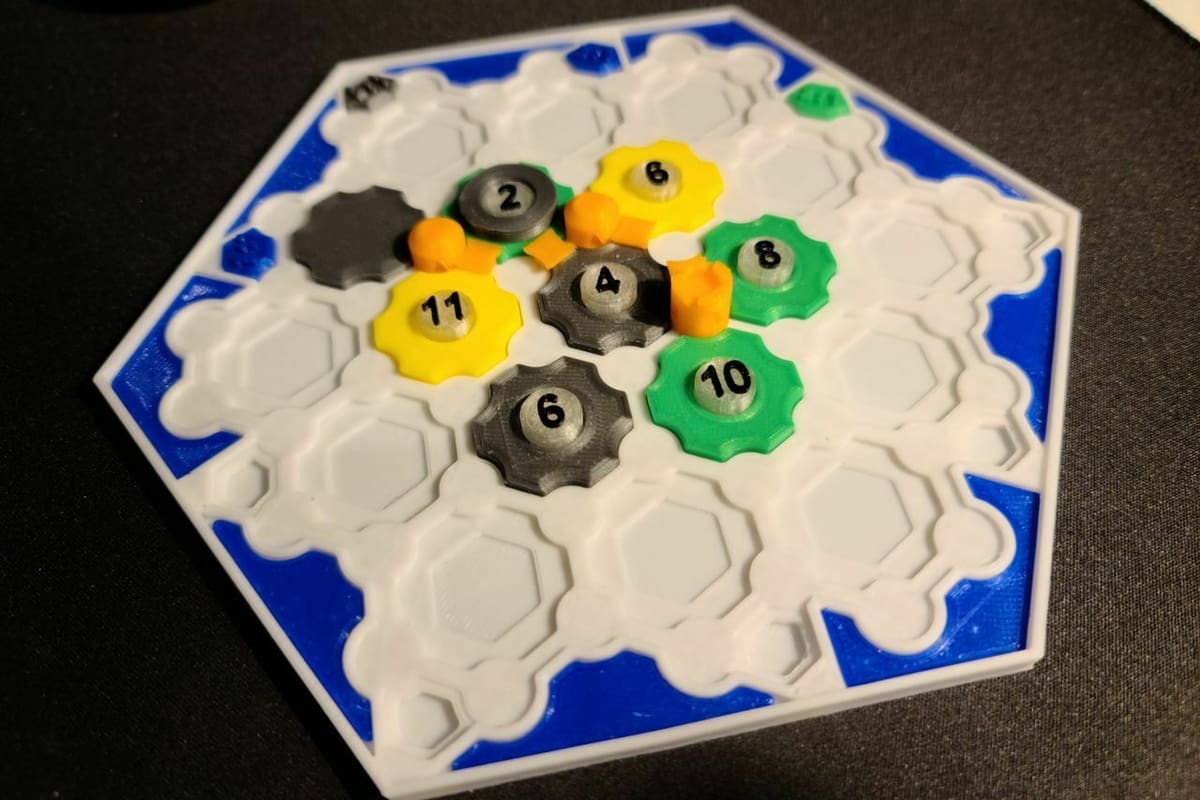
Hey, that Catan grind can’t be stopped! You have to keep expanding, no matter the place, no matter the time. However, since Catan’s board requires so many small pieces, playing on the go can be difficult.
This designer has come up with a baseboard that can fit all the shapes snugly together so there is less risk of shuffling the number pieces or roads if the board gets tilted. Now you can carry it around and play wherever you are!
- Who designed it? BigBadBison
- How printable/popular is it? This model has three makes and four remixes, and the designer has included many useful tips to improve the quality of the print.
- Where to find it? Thingiverse
BattleFleet Star Wars vs. Star Trek
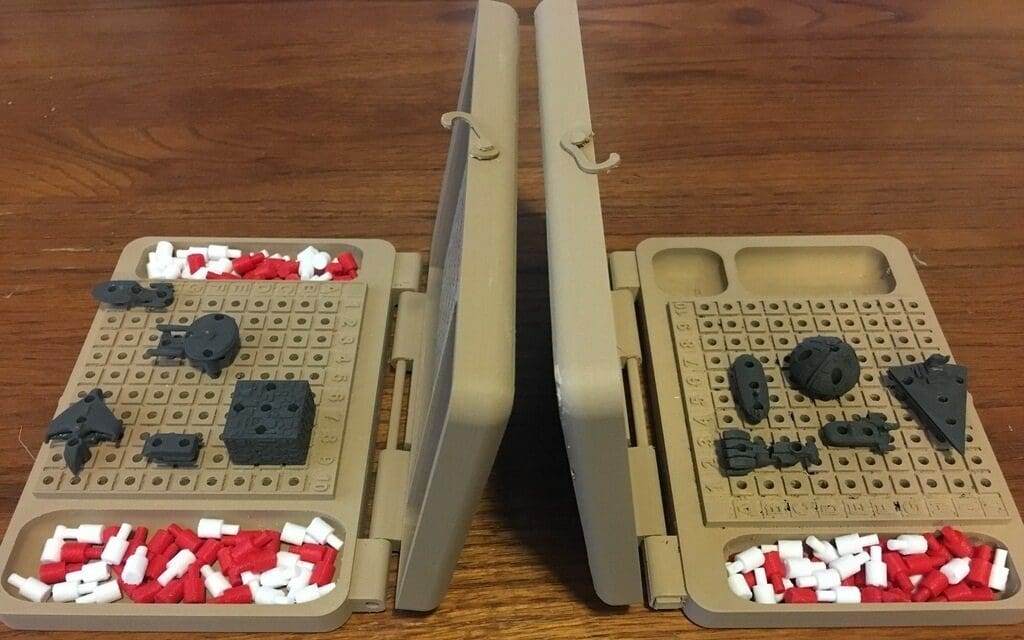
This game is half strategy, half psychology. Some people have the theory that players first shoot where they’ve placed ships on their own board. Others stack everything in the corners, while others avoid them completely.
With this version, you can easily pack it up and go, and keep fighting the rift of Star Wars vs. Star Trek until the end of time. The author recommends a higher infill on the bottom part of the board for stability.
- Who designed it? chemteacher628
- How printable/popular is it? The Battleship Travel board game has four makes and five remixes shared on Thingiverse.
- Where to find it? Thingiverse
Travel Tic-Tac-Toe

After many spin-offs of this game, we’ve finally come to what looks like the original. And you can play it anywhere!
Thanks to the smart design, the board can fit both the circles and crosses, and the pieces can even be stacked on top of each other for storage. To win, simply stack three in a horizontal, vertical, or diagonal line before your opponent.
- Who designed it? Henk
- How printable/popular is it? This model has 12 makes, with one user mentioning it prints well in PLA.
- Where to find it? Printables
Connect 4

As the classic Connect 4 goes, you win this game by stacking four discs in a row vertically, horizontally, or diagonally. Just make sure to do it before your opponent!
This miniature game includes storage in its base for all the pieces. You’ll need 25 in each color, and some glue is required to assemble the frame. For your discs to slide in without issue, you’ll need a good printing resolution and close dimensional accuracy. Otherwise, a bit of sanding could be necessary.
- Who designed it? OndrejStritesky
- How printable/popular is it? This model has 47 makes and 8 remixes.
- Where to find it? Printables
Pokémon on the Go
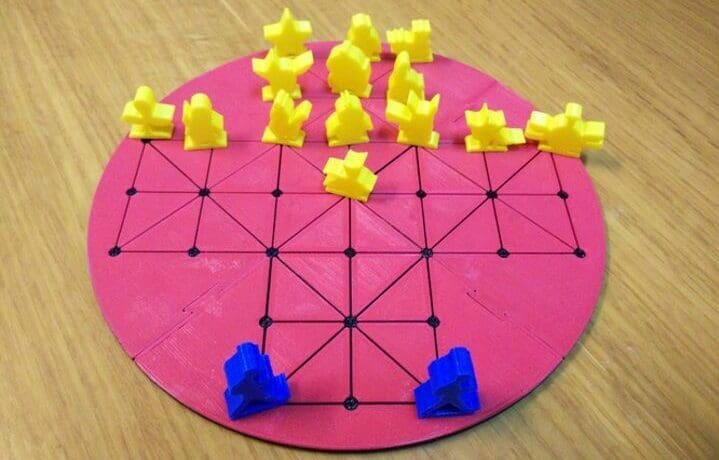
Spending too much time in front of a screen playing Pokémon? Well, it’s time to change that! Now you can play Pokémon off-screen, too. This is based on the game Fox and Geese but replaces the animals with Pokémon. Best of all, the gameboard can be disassembled, making it easy to take it on the go.
The author recommends using PLA at 20% infill and 2-mm layer height. They also suggest printing a Poké Ball to store all the pieces.
Pocket Sternhalma
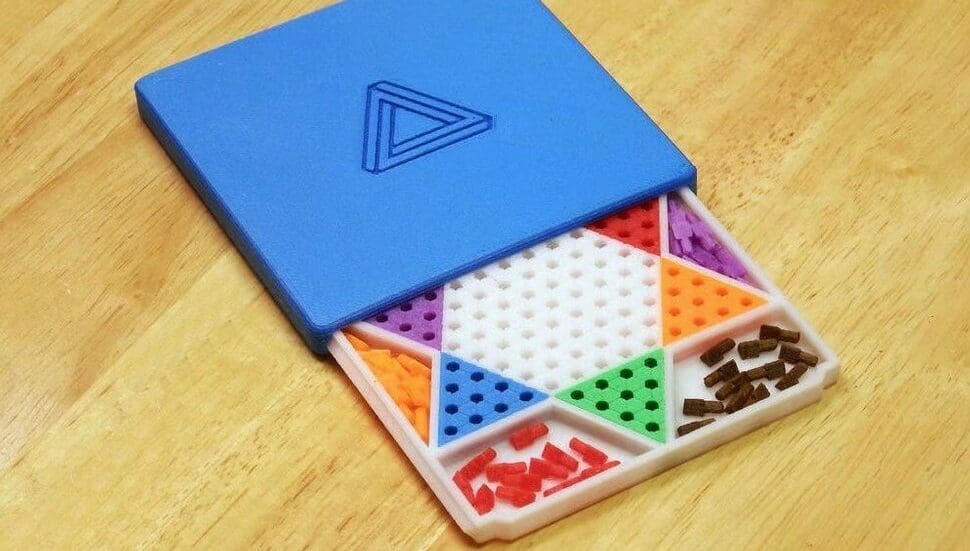
Sternhalma can be played by two to six players. However, because of the vast amount of pins – 60 to be exact – it can be a bit messy to carry around. This designer has come up with a brilliant way to make it portable without taking up too much space.
Since the pins in this scaled-down version are so tiny, you might want to add brims to keep them attached to the print bed.
- Who designed it? chuckbobuck
- How printable/popular is it? Three people have shared their successful prints so far, and one maker noted that the model is very well-designed with great tolerances.
- Where to find it? Thingiverse
License: The text of "40 Exciting 3D Printed Board Games" by All3DP is licensed under a Creative Commons Attribution 4.0 International License.






